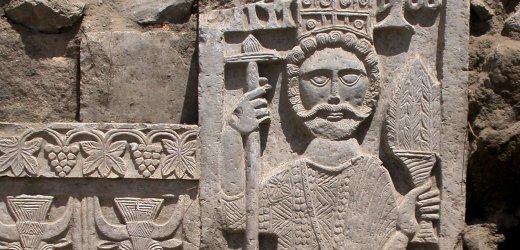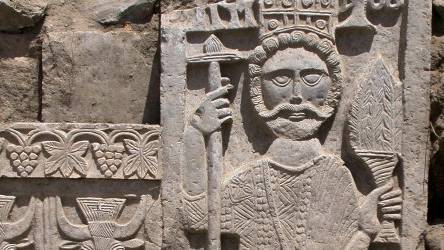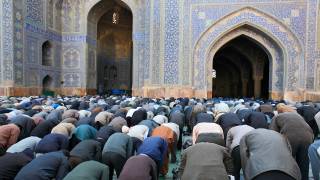Buried Christian Empire Casts New Light on Early Islam
Source: spiegel.de
Archeologists are studying the ruins of a buried Christian empire in the highlands of Yemen. The sites have sparked a number of questions about the early history of Islam. Was there once a church in Mecca?The commandment "Make yourself no graven image" has long been strictly followed in the Arab world. There are very few statues of the caliphs and ancient kings of the region. The pagan gods in the desert were usually worshipped in an "aniconic" way, that is, as beings without form.
Muhammad had a beard, but there are no portraits of him.
But now a narcissistic work of human self-portrayal has turned up in Yemen. It is a figure, chiseled in stone, which apparently stems from the era of the Prophet.
Paul Yule, an archeologist from the southwestern German city of Heidelberg, has studied the relief, which is 1.70 meters (5’7") tall, in Zafar, some 930 kilometers (581 miles) south of Mecca. It depicts a man with chains of jewelry, curls and spherical eyes. Yule dates the image to the time around 530 AD.

The "crowned man" relief found in Zafar, Yemen is seen as evidence that there was a Christian empire in the region before Islam took hold.
The German archeologist excavated sites in the rocky highlands of Yemen, an occupation that turned quite dangerous recently because of political circumstances in the country. On his last mission, Yule lost 8 kilograms (18 lbs.) and his equipment was confiscated.
Nevertheless, he is pleased, because he was able to bring notes, bits of debris and bones back to Heidelberg. Yule has concluded that Zafar was the center of an Arab tribal confederation, a realm that was two million square kilometers (about 772,000 square miles) large and exerted its influence all the way to Mecca.
Even more astonishing is his conclusion that kings who invoked the Bible lived in the highland settlement. The "crowned man" depicted on the relief was also a Christian.
Conquerers from Ancient Ethiopia
Yule has analyzed the mysterious, robed figure in a report for the academic journal Antiquity. He is barefoot, which is typical of Coptic saints. He is holding a bundle of twigs, a symbol of peace, in his left hand. There is a crossbar on his staff, giving it the appearance of a cross. In addition, he is wearing a crown on his head like the ones worn by the Christian rulers of ancient Ethiopia.
All of this suggests that the man with a strange, round face is a descendant of the conquerors from Africa who succeeded in making one of the boldest landing operations in ancient times.
In 525 AD, the Negus, or king, of Aksum dispatched a fleet across the Red Sea. Soldiers and fighting elephants were ferried across the water to the East on un-tarred, raft-like ships to spread the gospel. In the ensuing decades, his army captured large parts of Arabia.
The first spearhead was targeted at the capital Zafar. Like a fortress in the sky, the town was perched on an extinct volcano, at an altitude of 2,800 meters (9,184 feet) above sea level. Its walls, riddled with towers and alarm bells, were four-and-a-half kilometers long. About 25,000 people lived in Zafar.
According to Yule, between the 3rd and the 5th century the confederation managed to complete a "meteoric rise" and become a superpower. Its merchants traded in sandalwood from Ceylon and valerian from Persia. The state controlled the port of Aden, where the ships of spice traders from India docked. Frankincense, which was made in Arabia, was also traded. It was a place of luxury. Yule found wine amphorae, the remains of precious fish condiments and palaces decorated with sphinxes and lions.
A Peaceful Multi-Cultural Community
The social structure in Zafar also appeared to be unique. The city had a large Jewish community, as evidenced by a seal with a Torah niche. Hebrew inscriptions were discovered. Zafar’s residents also included Christians, who built a church there in 354 AD. Arabs who worshipped old idols lived in the alleys.
But this peaceful, multicultural community soon came to an end, as tensions began to mount in the 5th century, and Arabia was transformed into a front.
The Byzantine Empire, bristling with weapons, operated in the west, and its vassals kept making inroads toward the desert. They were accompanied by Christian missionaries, who brought the doctrine of the Holy Trinity to the shepherds on the edge of the Rub’ al Khali, the sand desert that makes up much of the southern third of the Arabian Peninsula.
[...]
Read the full article at: spiegel.de






















